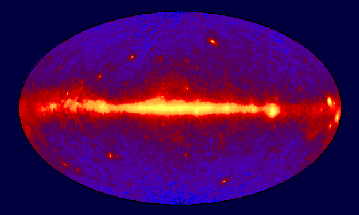|
|
High-Energy Gamma-Ray Instrument Design
Looking at the Sky in a New Light
| Suppose you wanted to take pictures of the sky in gamma-ray light.
These pictures would reveal the violent, explosive face of the
Universe, because gamma-rays are the most powerful type of light. In
fact, gamma-rays are so energetic that they behave more like particles
than waves. For example, there are no gamma-ray mirrors or lenses.
Gamma-ray telescopes cannot focus gamma-rays, so they must have large
detecting areas. Because of the power of gamma-rays, these telescopes
must also be massive to stop all that energy. Yet despite their
energy, gamma-rays cannot penetrate the earth's atmosphere; gamma-ray
astronomy is mostly carried out from space. Much of the research in
gamma-ray astronomy is devoted to finding better ways to take gamma-ray
pictures of the sky. |

EGRET All-Sky Map |
Collecting these photons is HARD. There are just not that many of them
around. The technology that is used is basically that of particle
accelerators here on Earth (that is the only source here of lots of
gamma-rays, for testing and calibration, for example).
What Else Makes Observing Gamma-Rays
Hard?
Tell Me About Flying Gamma-Ray Detectors
On Balloons
Gamma-Ray Telescopes on CGRO
Four gamma-ray experiments are now working on board the Compton Gamma
Ray Observatory satellite, a huge satellite launched from the Space
Shuttle in 1991. These experiments are studying a wide range of violent
processes and objects in the Universe: pulsars, quasars, supernovae,
collisions between cosmic rays and gas molecules, gamma-ray bursts, and
many stars or galaxies that remain mysteries.
Tell me moreabout the instruments on board CGRO (http://cossc.gsfc.nasa.gov/cossc/epo/)
Future Projects
Because gamma-ray telescopes on the Compton Observatory were designed
in the 1970s, they cannot take pictures that are as clear as radio,
optical, or X-ray telescopes. New ways to detect and measure gamma-rays
have been developed since then, and so a group at GSFC and other
gamma-ray astronomers are
now planning new telescopes that will help solve some of the gamma-ray
mysteries. One of these new telescopes, called INTEGRAL (http://astro.estec.esa.nl/SA-general/Projects/Integral/integral.html), is being built by
European
scientists with help from some U.S. scientists. It will study many of
the sources of gamma-rays like supernovae. Other gamma-ray telescopes
being developed, like one called GLAST (http://www-glast.stanford.edu/), which will make maps of the
whole sky with much higher resolution than the current telescopes. These
telescopes should bring the picture of the gamma-ray sky into better
focus, letting scientists see the high-energy Universe far more
clearly.
Some other things that are currently being developed/explored are
observing nuclear
lines. These lines (at low gamma-ray energies) are similar to the
emission lines caused by electron transitions when an element is heated
up, but they are much higher energies and they come from nuclear
transitions when an element is really heated up
(i.e. very very close to
a black hole, for example). These are unique probes into areas that
would not otherwise be accessible.
Thank you to David Thompson for contributing to this article.
|
